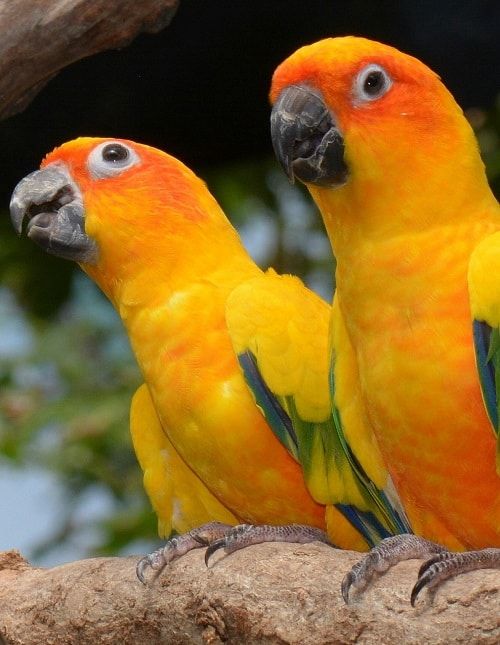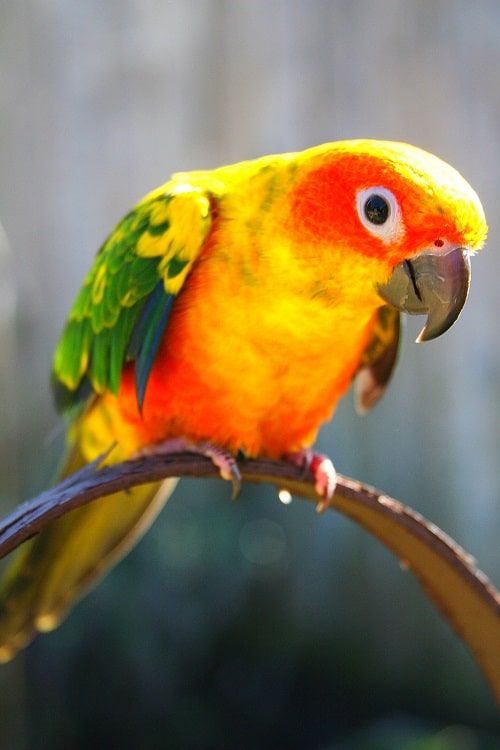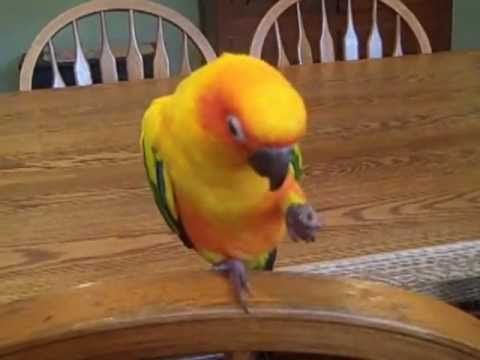The amazingly colorful sun conure is a pretty popular parrot to keep as a pet and it’s not difficult to see why: their bright plumage and snuggly but mischievous personalities are sure to steal anyone’s heart.
If you add a sun conure to your family, can you expect it to imitate your voice? Can sun conures talk? Find out all about their talking abilities and how to train yours to say a few words or phrases.
Do sun conures talk?
If you’ve ever owned a conure from the Aratinga genus before, you’ll know that they are loud. Sun conures (Aratinga solstitialis) is no exception: its flock call carries for miles in its natural rainforest habitat.
Among the chatter your sun conure produces you might be able to distinguish some talking. Although their potential vocabularies are not comparable to those of champion talkers like African grey parrots or Amazons, some birds can learn a couple of words or short phrases. Sun conures’ normal calls are more like shrieks, while the voice they use to imitate humans is almost a bit robotic.
Sun conure owners have reported that more than words or sentences, these birds have an interest in sounds. You’ll much sooner find your sun conure imitating the microwave, telephone or your laugh than saying ‘good morning’. This especially applies if you haven’t done any specific talking training with your bird.
Tip: You can find a more extensive list of the talented talkers of the parrot world in the article about what parrots can talk.

How to teach a sun conure to talk
What influences talking ability?
Not all sun conures will learn to talk. Some will never even imitate anything at all, even sounds that they hear many times a day. Others, on the other hand, turn out exceptionally gifted for their species and far surpass the normal eagerness to learn words and sounds.
A few factors that influence sun conure talking are:
- Age. As with most animals (and humans!), sun conures pick up new skills more easily and are more receptive to training when they’re still young.
Once they’re past a year or two and set in their ways, it’s more challenging to get them to do new things, although that doesn’t in any way mean that any older conure is incapable of learning to talk. It just means it might need some more training and the chance that it never gets into it is unfortunately a bit greater.
- Upbringing. A sun conure that was raised with lots of human contact and associates humans with positive things is more likely to imitate them. After all, as mentioned in the article on why parrots talk, imitation is a way for parrots to socialize and fit in. This means that they have to see you as members of the flock to be receptive to you.
The tamer your conure, the greater your chances of success; again, though, this doesn’t mean that it’s impossible for a non-tamed sun conure to learn to speak. Just less likely.
- You! Whether your sun conure will learn to imitate your voice is almost completely in your hands. It’s up to you to make sure that your bird is happy, healthy and comfortable. Then once it’s time to start training, it’s also up to you to be ever so patient and approach the training sessions in a productive manner.
Basically, if you’re not willing to endlessly repeat a phrase for weeks on end, you might not be cut out for parrot talking training!
Tip: Parrots usually need a while to start speaking. Sun conures seem to commence their talking practice when they’re around a year old.

Teaching a sun conure to talk through positive reinforcement
The best way to train a parrot is through the practice of positive reinforcement. This means that instead of punishing the bird when it does something bad, you reward it when it does something good. Positive reinforcement works perfectly for talking training.
As mentioned before, some parrots will simply never talk. However, with the steps below and a good dose of patience you should hopefully start hearing the first words soon!
Tip: If your sun conure is not entirely hand tame yet, that’s okay. The training you’re going to be doing actually helps with bonding too!
- Make sure your sun conure is healthy, comfortable and free of stress. Feed a varied diet, provide a big cage with plenty of toys and make sure to let the bird out of its cage for multiple hours a day.
- Pick a word, phrase or sound that you would like to teach your conure. Stick to easy stuff at first: hi, birdie, good night, stuff like that.
- Work on creating a positive association with you and your voice. Your bird should associate you with happy things: food, attention, exploration and toys. Offer a little snack whenever you approach the cage or take the bird out to hang out with you for a bit.
- Once you’re sure that your bird is comfortable with you, you can start doing little training sessions where you take it out of its cage and to a quiet place without distractions. Hang out there for a few minutes playing, giving head scratches and offering some tasty treats while speaking in a clear voice.
- Whatever you do, don’t forget to always be chatting to your sun conure! The “focus word” especially should be repeated often: you’re trying to build a relationship with your sun conure so that it sees you as a member of the flock, as that will make it more likely to want to imitate you. Additionally, you’re trying to lodge the focus word in its mind by repeating it constantly during positive experiences.
- It can take really long before your sun conure picks up a word, or alternatively it might get it within a few days. Parrot training is a hobby for the patient!
- If you hear your sun conure attempting to say the focus word, shower it in praise. A little treat is always good if you have one on hand, but if you don’t, parrots will also perceive attention and excited speaking as rewarding.
Tip: To help get your bird excited, try bobbing it gently up and down or swaying it side to side on your hand. Some of them just love doing a little “dance”!

Examples of sun conures talking
As you can see in the videos below, sun conures are by no means the most talented talkers out there. They try, though, and are eager to learn.
If you have any more questions about sun conure talking or if you want to share your own experiences with these colorful neotropical parrots, don’t hesitate to leave a comment below!



Can’t find the color u have only green cheek most all pet stores. Any suggestions
Sun conures are a different species. If you’re interested in getting one, your best bet might be to find a (hobbyist) breeder!
My beautiful little boy Pancho is a cinnamon conure he talks to me All the time ,he says pretty boy up down what and love you right now but he is learning everyday I got him when he was 2 months old
Thanks for sharing! That’s lovely 🙂